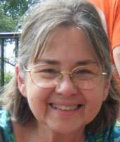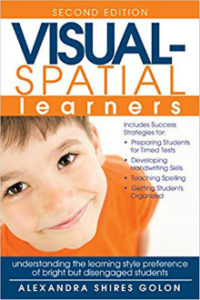Helping Visual-Spatial Learners Be Successful
Visual-Spatial Learners: Understanding the Learning Style Preference of Bright But Disengaged Students, 2nd edition
By Alexandra Shires Golon
(Prufrock Press, 2017 – Learn more)

I have been doing a lot of research on ADHD to find out about any current developments. One article that I ran across listed indicators of visual-spatial learners. This list happens to coincide with some of the indicators of ADHD. So I became very interested in reading and reviewing this book by Alexandra Shires Golon.

Right versus left
Auditory-sequential learners favor the left side of the brain because this side deals with the function of language. These students do well in reading, writing, spelling and organization. They think mainly in words, attend to details and thrive with step-by-step learning methods. Our classrooms are mostly set up to facilitate this type of learner.
The right side of the brain concentrates on understanding the tone of voice and body clues to assist us in interpreting language. Visual-spatial learners favor this side and many are creatively, technologically, mechanically, emotionally or spiritually talented, think in images, see the big picture and thrive where instruction is a whole-to-part method (p.12).
What research tells us
Golon’s research and work with the Gifted Development Center staff supports the theory that possibly 45% of all students in a regular classroom prefer a visual-spatial method of learning. Further, her book states that favoring the right hemisphere increases with intellectual ability, with as many as 70% of students enrolled in gifted classes found to also prefer visual-spatial techniques.
Right hemisphere engagement is not only a helpful differentiation strategy for students generally, it can also increase their attention. Attention is lower and learning is less than stellar if the right side of the brain is not activated. Neuroscientists studying the brain found that the flashes of ideas that come before “Aha” moments show a lot of neural activity in the right hemisphere.
A subject-by-subject look at what can help visual-spatial learners
All of this research-based information should instill a desire among teachers to make our rooms more conducive to the visual-spatial learners. Here again the author assists by giving us specific ideas for most subjects.
Going through the subjects, starting with reading, Golon gives many examples of strategies to use with visual-spatial learners. In reading, she suggests that a sight word approach often works better that a phonetic method because these learners can’t see any “pictures” in small word parts.
In writing, visual-spatial learners have more trouble translating the images in their heads into words and trying to get them down on paper or into the computer. Having a voice activated computer program or a scribe is immensely helpful, says Golon. There are also very good suggestions for organizing data in preparation for writing a report when these students absolutely have to follow traditional methods.
Math, spelling, social studies, organization and focus are all covered in subsequent chapters. Included is The Dreaded Timed Test, which is the bane of existence for visual-spatial thinkers. One of the ideas is to play any game using a timer. This helps to get them used to time limits.
Supporting learners for the Conceptual Age
Chapter 11 has many useful suggestions for using the strengths of these students to learn new material. The one that I want to employ more in my classroom is using metaphors to show connections between the new information and the old or previously known data.
In this book, the author highlights both strengths and weaknesses of the visual-spatial students while also giving us ideas to further their development of skills. She further states, “Although they usually have trouble with their schoolwork, they are highly prized as adults whose very skills and talents future careers will rely on…. [B]ecause they can dream, create, invent and inspire they were born to excel.” (p.17).
We definitely need these visual-spatial thinkers to be successful as we move from the Information Age into the Conceptual Age, and this book will help.
Joanne Bell is a middle school teacher at St. Joseph Elementary School in Cottleville, Missouri. She currently teaches social studies to sixth and seventh graders and is working on a blog about ADHD entitled http://thinkingthroughadhd.com/.




































